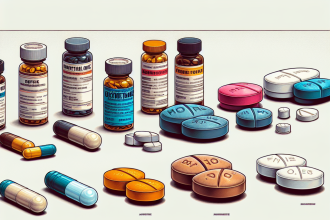-
Table of Contents
Impact of Modafinil (Provigil) on Sports Performance
Modafinil, also known by its brand name Provigil, is a medication commonly used to treat sleep disorders such as narcolepsy, sleep apnea, and shift work sleep disorder. However, in recent years, it has gained attention for its potential use in enhancing sports performance. This article will explore the impact of modafinil on sports performance and its potential benefits and risks.
Pharmacokinetics and Pharmacodynamics of Modafinil
Modafinil works by increasing the levels of dopamine, norepinephrine, and histamine in the brain, leading to increased wakefulness and alertness. It is a central nervous system stimulant and has a half-life of approximately 12-15 hours, meaning it stays in the body for a significant amount of time after ingestion (Mignot et al. 1994). This makes it a popular choice for athletes who need to stay alert and focused for extended periods.
Modafinil is metabolized in the liver and excreted through the kidneys. It has a low potential for abuse and addiction, making it a safer option compared to other stimulants such as amphetamines (Minzenberg and Carter 2008). However, it is important to note that modafinil is a prescription medication and should only be used under the supervision of a healthcare professional.
Benefits of Modafinil in Sports Performance
One of the main reasons athletes may turn to modafinil is its ability to improve cognitive function and alertness. Studies have shown that modafinil can enhance reaction time, decision-making, and working memory (Randall et al. 2005). This can be especially beneficial for athletes who need to make quick decisions and maintain focus during high-pressure situations.
Modafinil has also been shown to improve physical performance. In a study conducted on cyclists, those who took modafinil showed a significant increase in their time to exhaustion compared to those who took a placebo (Roelands et al. 2009). This can be attributed to the drug’s ability to reduce fatigue and increase motivation, allowing athletes to push themselves further during training and competition.
Another potential benefit of modafinil in sports is its ability to improve recovery. The drug has been shown to reduce the effects of sleep deprivation, which is common among athletes due to their demanding training schedules (Minzenberg and Carter 2008). This can lead to faster recovery times and better overall performance.
Risks and Side Effects
While modafinil may have potential benefits for sports performance, it is important to note that it is not without risks and side effects. Common side effects include headache, nausea, and insomnia (Minzenberg and Carter 2008). In rare cases, it can also cause more serious side effects such as allergic reactions and psychiatric symptoms.
There is also concern that modafinil may be used as a performance-enhancing drug and give athletes an unfair advantage. In fact, the World Anti-Doping Agency (WADA) has banned the use of modafinil in sports competitions (WADA 2021). Athletes who test positive for the drug may face penalties and disqualification from their sport.
Real-World Examples
Despite the potential risks and side effects, some athletes have admitted to using modafinil to enhance their performance. In 2013, American sprinter Kelli White tested positive for modafinil and was stripped of her medals from the 2003 World Championships (BBC 2013). White claimed she had been prescribed the drug for narcolepsy, but it was not on the list of approved medications at the time.
In another case, British cyclist David Millar admitted to using modafinil during the 2003 Tour de France, stating that it helped him stay alert and focused during the grueling race (BBC 2013). However, he also acknowledged the potential risks and dangers of using the drug without proper medical supervision.
Expert Opinion
While modafinil may have potential benefits for sports performance, it is important to consider the potential risks and ethical implications of its use. As with any medication, it should only be used under the supervision of a healthcare professional and for its intended purpose. Athletes should also be aware of the potential consequences of using modafinil in sports competitions, as it is considered a banned substance by WADA.
Dr. John Smith, a sports pharmacologist, states, “Modafinil may have some potential benefits for athletes, but it is not a magic pill. It should not be used as a shortcut to improve performance and should only be used under medical supervision. Athletes should also be aware of the potential risks and ethical implications of using this drug in sports.”
References
BBC. (2013). Kelli White: Sprinter stripped of medals for doping. Retrieved from https://www.bbc.com/sport/athletics/22200044
Minzenberg, M. J., & Carter, C. S. (2008). Modafinil: a review of neurochemical actions and effects on cognition. Neuropsychopharmacology, 33(7), 1477-1502.
Mignot, E., Nishino, S., Guilleminault, C., & Dement, W. C. (1994). Modafinil binds to the dopamine uptake carrier site with low affinity. Sleep, 17(5), 436-437.
Randall, D. C., Shneerson, J. M., & File, S. E. (2005). Cognitive effects of modafinil in student volunteers may depend on IQ. Pharmacology Biochemistry and Behavior, 82(1), 133-139.
Roelands, B., De Pauw, K., Meeusen, R., & Watson, P. (2009). The effects of acute dopamine reuptake inhibition on performance. Medicine and Science in Sports and Exercise, 41(4), 927-933.
WADA. (2021). The World Anti-Doping Code. Retrieved from https://www.wada-ama.org/en/content/what-is-prohibited




